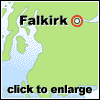
|
The Scottish Wars of Independence Continued from Page Two
The Wallaces had probably come from Shropshire originally sometime during the twelfth century and had gained land in the parish of Paisley. There they were subject to the lordship of the Stewarts.
The rising of Wallace in 1297 must be placed into some context. Wallace's standing and ability to operate required that he have support or at least no hostility from Sir James Stewart his lord. Moreover, as the son of a knight and possibly a minor landholder, he would have the ability to bring together some trained men for his struggle.
It is commonly assumed that Wallace led a band of outlaws and common men. While there would undoubtedly have been many like this in his band, some of his exploits required trained men with horses. Moreover, it should be stated that Wallace was not alone in this struggle. In the north a young knight Sir Andrew Moray, was engaged in a widespread and highly effective campaign to rid the English from the north of Scotland. A campaign Wallace certainly was not involved in.
After this victory, Wallace and a severely wounded Moray were appointed Guardians of Scotland and promptly invaded England over the winter of 1297/8 causing widespread havoc. At some point around this time, Wallace was knighted. The only source for this is a reliable English one. The source states simply that one of the great nobles had knighted him. At the time, there were only three present in Scotland, the earls of Strathearn, Lennox and Carrick. It is from this evidence that the story has grown that it was the earl of Carrick, Robert Bruce who carried out the ceremony. However it is equally possible that Lennox or even Strathearn did it instead.
Links: Famous Scot: Alexander III on GOTC Famous Scot: Robert the Bruce on GOTC Robert the Bruce's Heart on GOTC Robert the Bruce Murders John Comyn on GOTC Famous Scot: William Wallace on GOTC |
Thursday, December 26th, 2019
Attention visitors: Tartans.com is back. Please note that this is a snapshot of the site as it existed nearly 20 years ago and you may encounter broken links; we are still combing through the site and correcting those as we find them. Please also note that some sections are currently not functional, primarily the discussion forums/clan chat boards.
|
** HOME - First Time Visitors - Glossary - - Contact Us ** Awards | Bibliography | Clan Calendar | Clan Chat | Clan Finder | History | Famous Scots | Genealogy | Great Hall of the Clans | Links | News and Features | Scots on the Net | Search | Site Map The Gathering of the Clans
Copyright 1995- Tartans.com - All Rights Reserved. |


